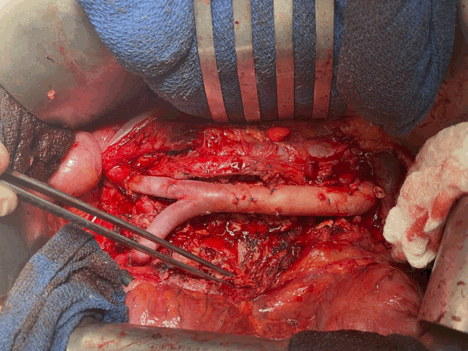DEMOGRAPHICS:
53-year-old male with HIV and disseminated mycobacterium avium complex (MAC).
HISTORY:
In 2020, he presented with chest pain secondary to a ruptured type V thoracoabdominal aneurysm (TAAA) and an isolated 7.1 cm infrarenal abdominal aortic aneurysm (AAA).
PLAN:
We performed emergent repair of his TAAA utilizing a rifampin impregnated dacron graft (RIDG) and beveled anastomosis to include the celiac and superior mesenteric artery origins. Tissue culture grew acid fast bacilli.
Seventeen days after repair of his TAAA, there was concern for impending AAA rupture. While endovascular aortic repair (EVAR) is not considered a reliable permanent treatment for mycotic aneurysms, he was unlikely to tolerate another open aortic surgery. EVAR was chosen to stabilize his AAA and allow for recovery. He underwent urgent EVAR with a rifampin soaked 23 x 14 x 104 mm Medtronic Endurant endograft, bilateral iliac branch extensions, and iliac kissing stents.
Three years later, the patient presented with back pain. CTA revealed a 7.5 centimeter periaortic fluid collection eroding L3-L4 vertebrae and extending down the left psoas muscle. Cultures again grew acid fast bacilli; mycobacterium avium complex.
Antimycobacterial antibiotics were initiated. We explanted the endograft using wire cutters to separate the suprarenal fixation stents and performed an in-situ repair using a cryopreserved cadaveric aortic homograft. (Figure 1) A pedicled omental flap was sutured over the graft to decrease risk of re-infection and aorto-enteric fistula.
DISCUSSION:
To our knowledge, there are only four reported cases of MAC causing an aortic infection. Management was dictated by the complex evolution of his infection. In-situ repair with cadaveric aortic homograft offers superior durability and freedom from reinfection when compared to extra-anatomical bypass. In the emergent setting, as in the case of this patientís ruptured TAAA, cadaveric homografts may not be available and use of RIDG provides similar outcomes. While EVAR is not a reliable permanent treatment for mycotic aneurysms, in this clinical setting, it likely prevented AAA rupture and bridged the patient to definitive repair with cadaveric aortic homograft.
This case demonstrates successful treatment of both mycotic and aortic graft infection in a patient with MAC infection and HIV.
Figure 1 